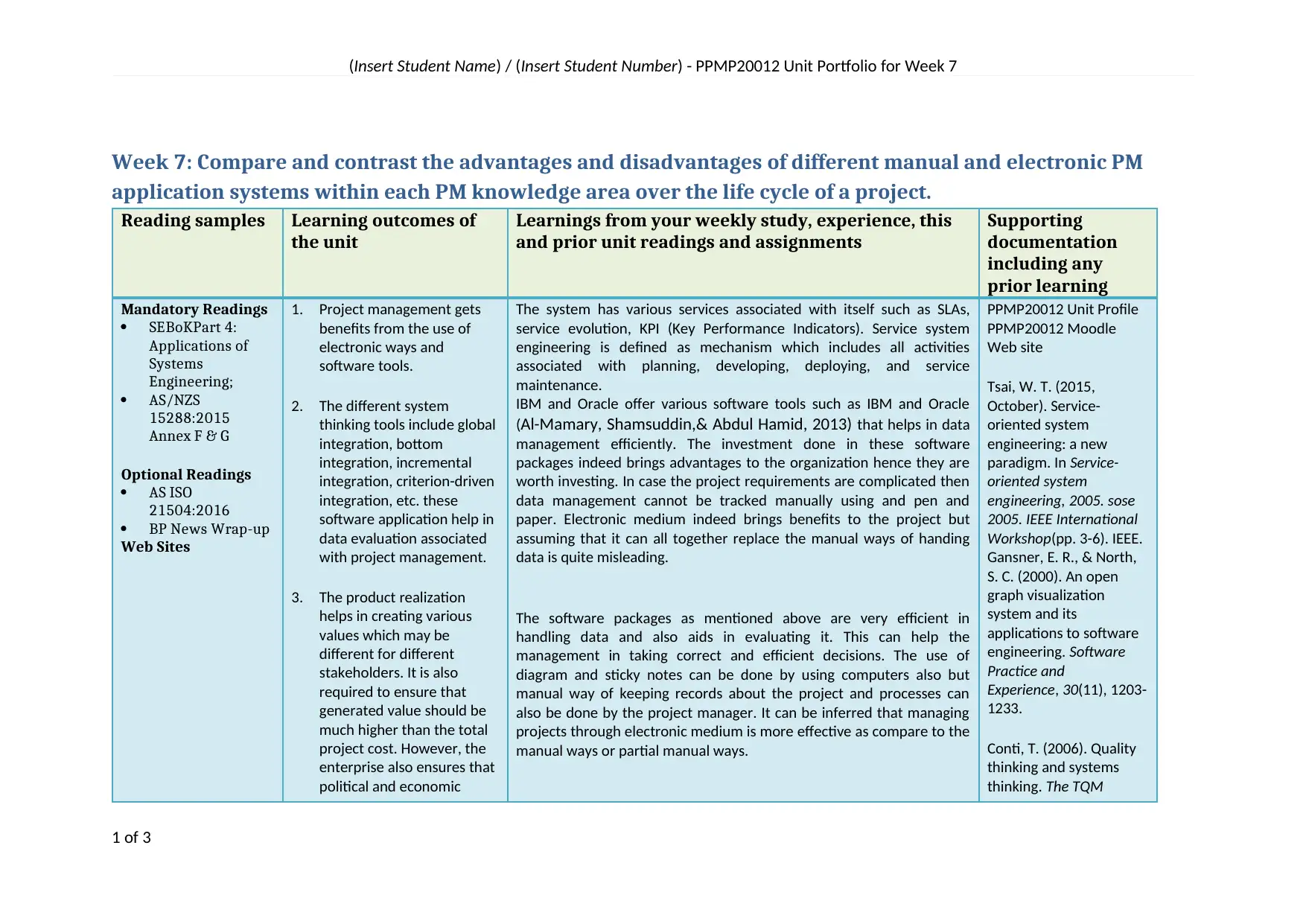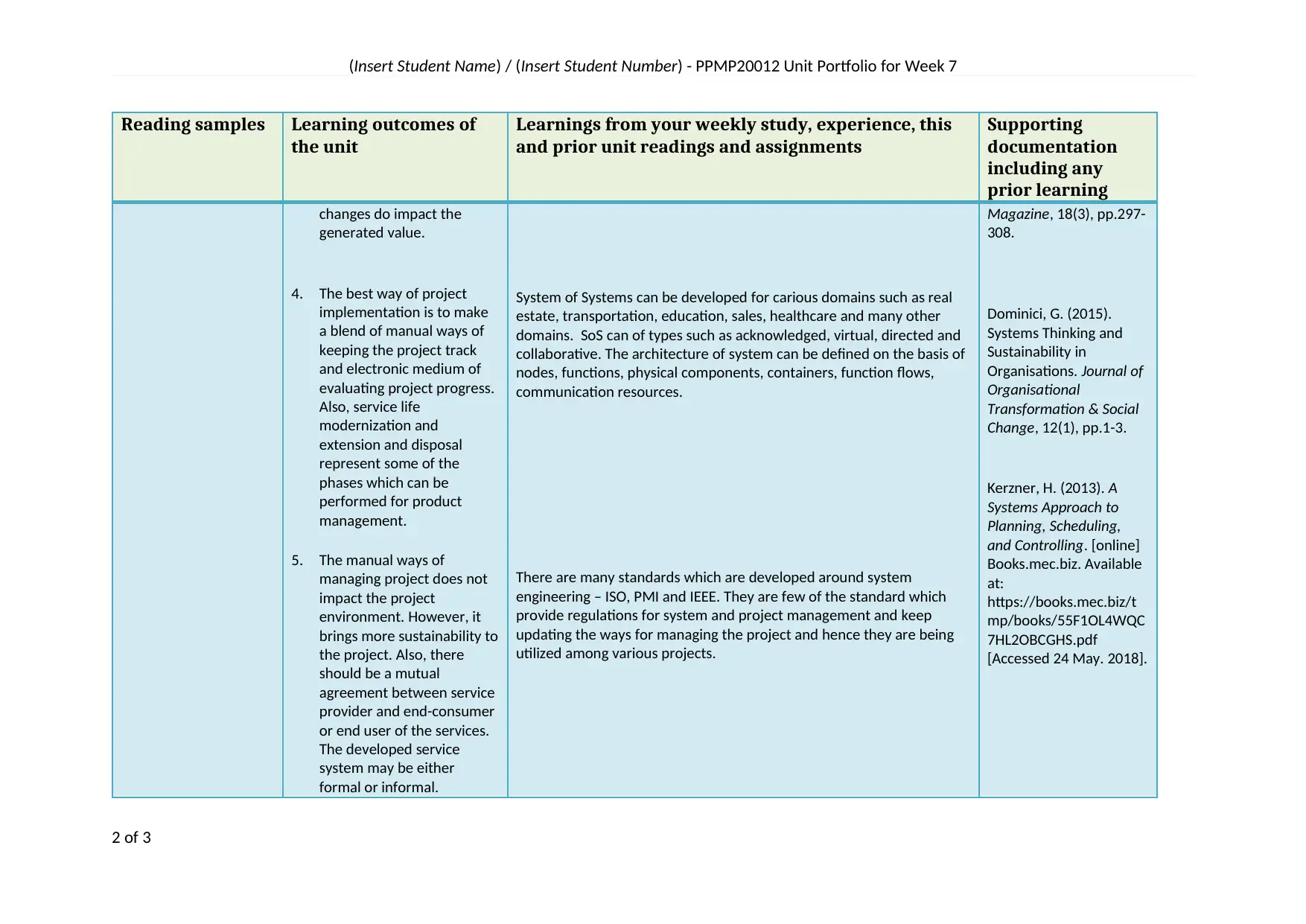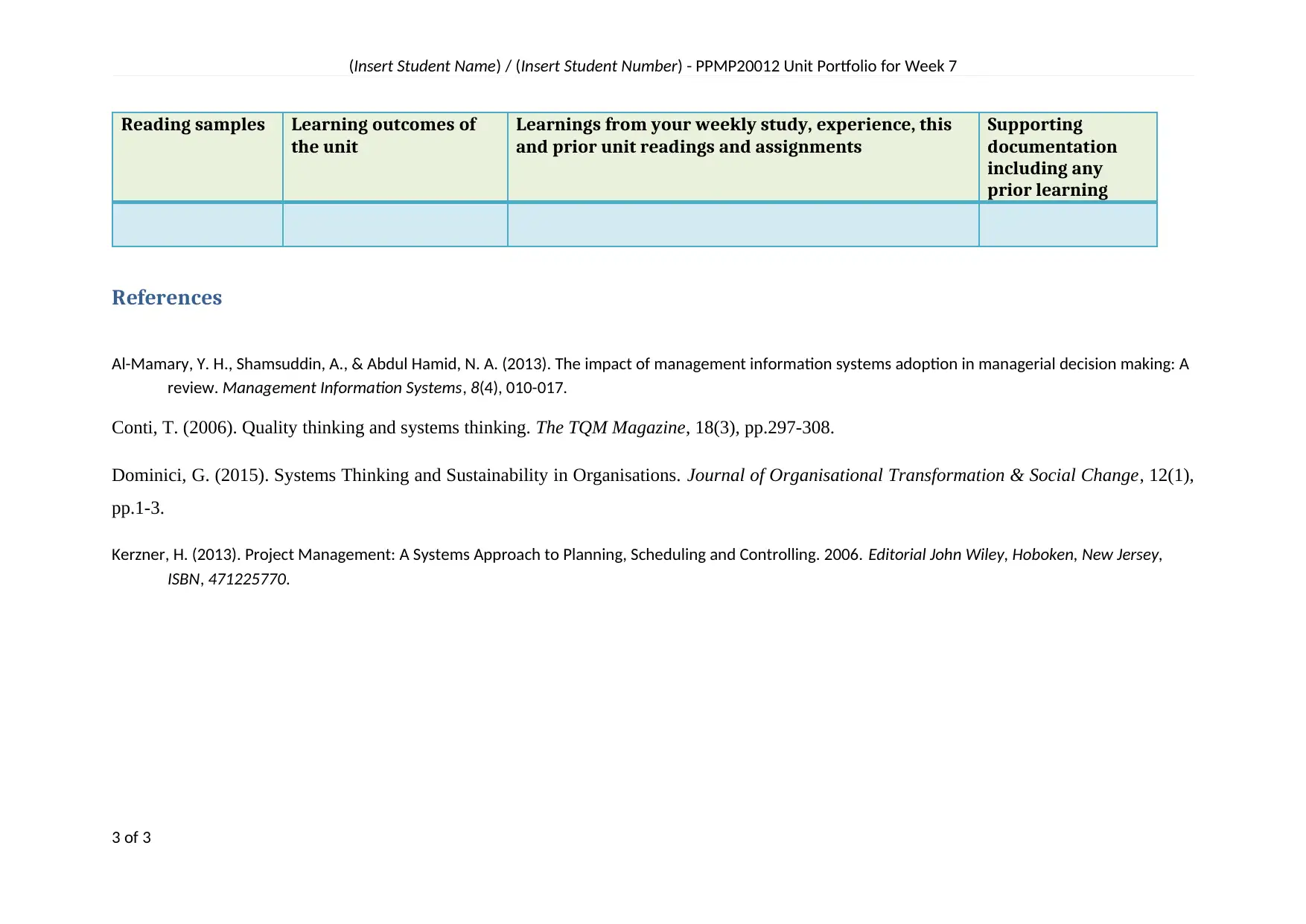Compare PM Systems: PPMP20012 Unit Portfolio Week 7 Analysis
VerifiedAdded on 2021/06/17
|3
|961
|139
Report
AI Summary
This report, a student submission for PPMP20012, analyzes the advantages and disadvantages of manual and electronic project management (PM) application systems across the project lifecycle. The report explores various system thinking tools, emphasizing the benefits of integrating electronic methods for data evaluation and decision-making while acknowledging the value of manual approaches for project tracking and sustainability. The report references software tools like those offered by IBM and Oracle, highlighting their efficiency in data management. The discussion covers system of systems (SoS), standards like ISO, PMI, and IEEE, and the importance of service system engineering. The report concludes that a blend of manual and electronic methods is the most effective approach to project management, citing relevant literature and references.

(Insert Student Name) / (Insert Student Number) - PPMP20012 Unit Portfolio for Week 7
Week 7: Compare and contrast the advantages and disadvantages of different manual and electronic PM
application systems within each PM knowledge area over the life cycle of a project.
Reading samples Learning outcomes of
the unit
Learnings from your weekly study, experience, this
and prior unit readings and assignments
Supporting
documentation
including any
prior learning
Mandatory Readings
SEBoKPart 4:
Applications of
Systems
Engineering;
AS/NZS
15288:2015
Annex F & G
Optional Readings
AS ISO
21504:2016
BP News Wrap-up
Web Sites
1. Project management gets
benefits from the use of
electronic ways and
software tools.
2. The different system
thinking tools include global
integration, bottom
integration, incremental
integration, criterion-driven
integration, etc. these
software application help in
data evaluation associated
with project management.
3. The product realization
helps in creating various
values which may be
different for different
stakeholders. It is also
required to ensure that
generated value should be
much higher than the total
project cost. However, the
enterprise also ensures that
political and economic
The system has various services associated with itself such as SLAs,
service evolution, KPI (Key Performance Indicators). Service system
engineering is defined as mechanism which includes all activities
associated with planning, developing, deploying, and service
maintenance.
IBM and Oracle offer various software tools such as IBM and Oracle
(Al-Mamary, Shamsuddin,& Abdul Hamid, 2013) that helps in data
management efficiently. The investment done in these software
packages indeed brings advantages to the organization hence they are
worth investing. In case the project requirements are complicated then
data management cannot be tracked manually using and pen and
paper. Electronic medium indeed brings benefits to the project but
assuming that it can all together replace the manual ways of handing
data is quite misleading.
The software packages as mentioned above are very efficient in
handling data and also aids in evaluating it. This can help the
management in taking correct and efficient decisions. The use of
diagram and sticky notes can be done by using computers also but
manual way of keeping records about the project and processes can
also be done by the project manager. It can be inferred that managing
projects through electronic medium is more effective as compare to the
manual ways or partial manual ways.
PPMP20012 Unit Profile
PPMP20012 Moodle
Web site
Tsai, W. T. (2015,
October). Service-
oriented system
engineering: a new
paradigm. In Service-
oriented system
engineering, 2005. sose
2005. IEEE International
Workshop(pp. 3-6). IEEE.
Gansner, E. R., & North,
S. C. (2000). An open
graph visualization
system and its
applications to software
engineering. Software
Practice and
Experience, 30(11), 1203-
1233.
Conti, T. (2006). Quality
thinking and systems
thinking. The TQM
1 of 3
Week 7: Compare and contrast the advantages and disadvantages of different manual and electronic PM
application systems within each PM knowledge area over the life cycle of a project.
Reading samples Learning outcomes of
the unit
Learnings from your weekly study, experience, this
and prior unit readings and assignments
Supporting
documentation
including any
prior learning
Mandatory Readings
SEBoKPart 4:
Applications of
Systems
Engineering;
AS/NZS
15288:2015
Annex F & G
Optional Readings
AS ISO
21504:2016
BP News Wrap-up
Web Sites
1. Project management gets
benefits from the use of
electronic ways and
software tools.
2. The different system
thinking tools include global
integration, bottom
integration, incremental
integration, criterion-driven
integration, etc. these
software application help in
data evaluation associated
with project management.
3. The product realization
helps in creating various
values which may be
different for different
stakeholders. It is also
required to ensure that
generated value should be
much higher than the total
project cost. However, the
enterprise also ensures that
political and economic
The system has various services associated with itself such as SLAs,
service evolution, KPI (Key Performance Indicators). Service system
engineering is defined as mechanism which includes all activities
associated with planning, developing, deploying, and service
maintenance.
IBM and Oracle offer various software tools such as IBM and Oracle
(Al-Mamary, Shamsuddin,& Abdul Hamid, 2013) that helps in data
management efficiently. The investment done in these software
packages indeed brings advantages to the organization hence they are
worth investing. In case the project requirements are complicated then
data management cannot be tracked manually using and pen and
paper. Electronic medium indeed brings benefits to the project but
assuming that it can all together replace the manual ways of handing
data is quite misleading.
The software packages as mentioned above are very efficient in
handling data and also aids in evaluating it. This can help the
management in taking correct and efficient decisions. The use of
diagram and sticky notes can be done by using computers also but
manual way of keeping records about the project and processes can
also be done by the project manager. It can be inferred that managing
projects through electronic medium is more effective as compare to the
manual ways or partial manual ways.
PPMP20012 Unit Profile
PPMP20012 Moodle
Web site
Tsai, W. T. (2015,
October). Service-
oriented system
engineering: a new
paradigm. In Service-
oriented system
engineering, 2005. sose
2005. IEEE International
Workshop(pp. 3-6). IEEE.
Gansner, E. R., & North,
S. C. (2000). An open
graph visualization
system and its
applications to software
engineering. Software
Practice and
Experience, 30(11), 1203-
1233.
Conti, T. (2006). Quality
thinking and systems
thinking. The TQM
1 of 3
Paraphrase This Document
Need a fresh take? Get an instant paraphrase of this document with our AI Paraphraser

(Insert Student Name) / (Insert Student Number) - PPMP20012 Unit Portfolio for Week 7
Reading samples Learning outcomes of
the unit
Learnings from your weekly study, experience, this
and prior unit readings and assignments
Supporting
documentation
including any
prior learning
changes do impact the
generated value.
4. The best way of project
implementation is to make
a blend of manual ways of
keeping the project track
and electronic medium of
evaluating project progress.
Also, service life
modernization and
extension and disposal
represent some of the
phases which can be
performed for product
management.
5. The manual ways of
managing project does not
impact the project
environment. However, it
brings more sustainability to
the project. Also, there
should be a mutual
agreement between service
provider and end-consumer
or end user of the services.
The developed service
system may be either
formal or informal.
System of Systems can be developed for carious domains such as real
estate, transportation, education, sales, healthcare and many other
domains. SoS can of types such as acknowledged, virtual, directed and
collaborative. The architecture of system can be defined on the basis of
nodes, functions, physical components, containers, function flows,
communication resources.
There are many standards which are developed around system
engineering – ISO, PMI and IEEE. They are few of the standard which
provide regulations for system and project management and keep
updating the ways for managing the project and hence they are being
utilized among various projects.
Magazine, 18(3), pp.297-
308.
Dominici, G. (2015).
Systems Thinking and
Sustainability in
Organisations. Journal of
Organisational
Transformation & Social
Change, 12(1), pp.1-3.
Kerzner, H. (2013). A
Systems Approach to
Planning, Scheduling,
and Controlling. [online]
Books.mec.biz. Available
at:
https://books.mec.biz/t
mp/books/55F1OL4WQC
7HL2OBCGHS.pdf
[Accessed 24 May. 2018].
2 of 3
Reading samples Learning outcomes of
the unit
Learnings from your weekly study, experience, this
and prior unit readings and assignments
Supporting
documentation
including any
prior learning
changes do impact the
generated value.
4. The best way of project
implementation is to make
a blend of manual ways of
keeping the project track
and electronic medium of
evaluating project progress.
Also, service life
modernization and
extension and disposal
represent some of the
phases which can be
performed for product
management.
5. The manual ways of
managing project does not
impact the project
environment. However, it
brings more sustainability to
the project. Also, there
should be a mutual
agreement between service
provider and end-consumer
or end user of the services.
The developed service
system may be either
formal or informal.
System of Systems can be developed for carious domains such as real
estate, transportation, education, sales, healthcare and many other
domains. SoS can of types such as acknowledged, virtual, directed and
collaborative. The architecture of system can be defined on the basis of
nodes, functions, physical components, containers, function flows,
communication resources.
There are many standards which are developed around system
engineering – ISO, PMI and IEEE. They are few of the standard which
provide regulations for system and project management and keep
updating the ways for managing the project and hence they are being
utilized among various projects.
Magazine, 18(3), pp.297-
308.
Dominici, G. (2015).
Systems Thinking and
Sustainability in
Organisations. Journal of
Organisational
Transformation & Social
Change, 12(1), pp.1-3.
Kerzner, H. (2013). A
Systems Approach to
Planning, Scheduling,
and Controlling. [online]
Books.mec.biz. Available
at:
https://books.mec.biz/t
mp/books/55F1OL4WQC
7HL2OBCGHS.pdf
[Accessed 24 May. 2018].
2 of 3

(Insert Student Name) / (Insert Student Number) - PPMP20012 Unit Portfolio for Week 7
Reading samples Learning outcomes of
the unit
Learnings from your weekly study, experience, this
and prior unit readings and assignments
Supporting
documentation
including any
prior learning
References
Al-Mamary, Y. H., Shamsuddin, A., & Abdul Hamid, N. A. (2013). The impact of management information systems adoption in managerial decision making: A
review. Management Information Systems, 8(4), 010-017.
Conti, T. (2006). Quality thinking and systems thinking. The TQM Magazine, 18(3), pp.297-308.
Dominici, G. (2015). Systems Thinking and Sustainability in Organisations. Journal of Organisational Transformation & Social Change, 12(1),
pp.1-3.
Kerzner, H. (2013). Project Management: A Systems Approach to Planning, Scheduling and Controlling. 2006. Editorial John Wiley, Hoboken, New Jersey,
ISBN, 471225770.
3 of 3
Reading samples Learning outcomes of
the unit
Learnings from your weekly study, experience, this
and prior unit readings and assignments
Supporting
documentation
including any
prior learning
References
Al-Mamary, Y. H., Shamsuddin, A., & Abdul Hamid, N. A. (2013). The impact of management information systems adoption in managerial decision making: A
review. Management Information Systems, 8(4), 010-017.
Conti, T. (2006). Quality thinking and systems thinking. The TQM Magazine, 18(3), pp.297-308.
Dominici, G. (2015). Systems Thinking and Sustainability in Organisations. Journal of Organisational Transformation & Social Change, 12(1),
pp.1-3.
Kerzner, H. (2013). Project Management: A Systems Approach to Planning, Scheduling and Controlling. 2006. Editorial John Wiley, Hoboken, New Jersey,
ISBN, 471225770.
3 of 3
⊘ This is a preview!⊘
Do you want full access?
Subscribe today to unlock all pages.

Trusted by 1+ million students worldwide
1 out of 3
Related Documents
Your All-in-One AI-Powered Toolkit for Academic Success.
+13062052269
info@desklib.com
Available 24*7 on WhatsApp / Email
![[object Object]](/_next/static/media/star-bottom.7253800d.svg)
Unlock your academic potential
Copyright © 2020–2025 A2Z Services. All Rights Reserved. Developed and managed by ZUCOL.





